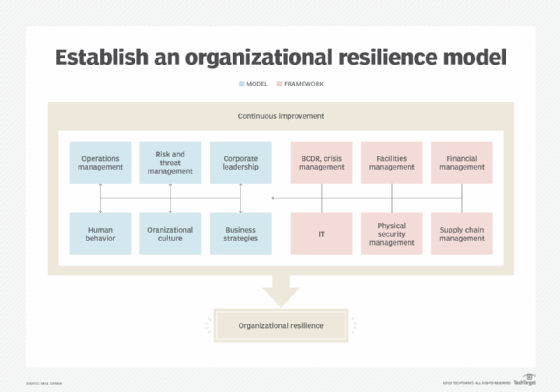
organization resilience
What is organizational resilience?
Organizational resilience is an organization's ability to anticipate issues ahead of time and develop a plan for handling identified problems. The organizational resilience methodology can be summed up as the following:
- Foresight (anticipate problems)
- Insight (interpret the situation and respond accordingly)
- Oversight (assess the action that has been taken)
- Hindsight (learn from the experience)
Why is organizational resilience important?
If an organization can anticipate and plan for an adverse situation, the eventual outcome will likely be more favorable than if the organization was taken by surprise.
Business continuity planning (BCP) and disaster recovery planning (DRP) are both subcomponents of organizational resilience. Organizational resilience is similar to BCP in that they both seek to help an organization survive a harmful event. Organizational resilience and DRP differ in that the former enables organizations to cope with both sudden disasters and slow incremental changes that might adversely affect the business, while DRP focuses on issues primarily caused by immediate failures.
An example of a slow incremental change is the way that television streaming services eventually led to the demise of video stores. Video stores did not go out of business overnight. Instead, it was a slow-moving disaster that occurred over time as more and more customers embraced streaming services. Had some of the larger chains of video stores anticipated and planned for the transition to streaming, they might still be around today. Nonetheless, the key takeaway is that organizational resilience ensures an organization's survival despite adverse circumstances, whether those circumstances are tied to a sudden event or a gradual change.
Even though organizational resilience is normally discussed in the context of surviving an event with minimal damage to the organization, a good organizational resilience plan can help an organization to prosper despite adversity. For example, the COVID-19 pandemic caused a lot of businesses to fail, but there were also businesses that were able to adapt to the changes and prospered even as their competitors were going bankrupt.

5 steps to build organizational resilience
The process of building organizational resilience is different for every organization. Even so, a Cranfield University report has identified the following five strategies for achieving organizational resilience.
Make reliability a priority. One of the keys to building organizational resilience is to encourage employees to think about things that could potentially go wrong and to find ways to address these potential problems and business resilience and reliability.
Dig deeper. When adverse events occur, there is often a temptation to think that the simplest explanation is most likely to be the correct one. However, an adverse event in business likely stems from another event, which might have even been triggered by yet another event. Resilient organizations often find that by examining an adverse event in depth, they can identify otherwise hidden causes. This puts the organization in a better position to recognize such an event in its earliest stages in the future, giving the organization more time to respond and adapt.
Decisions matter. Business leaders must understand that the decisions that they make in times of crisis can decisively determine the eventual outcome. As such, it is far better for those in charge to be able to follow a well-thought-out plan that already exists as a part of an organizational resilience framework than to make hasty guesses.
Work to solve problems. In any business, things can go wrong. Resilient organizations accept the idea that not every problem is preventable. However, with enough preplanning, it is possible to reduce the impact of most adverse events.
Trust experts. In most large organizations, there is a major disconnect between the business leaders and frontline workers. If an organization is to become resilient, its leaders must emphasize collaboration and trust employees who have expertise in an area that is relevant to the crisis.






